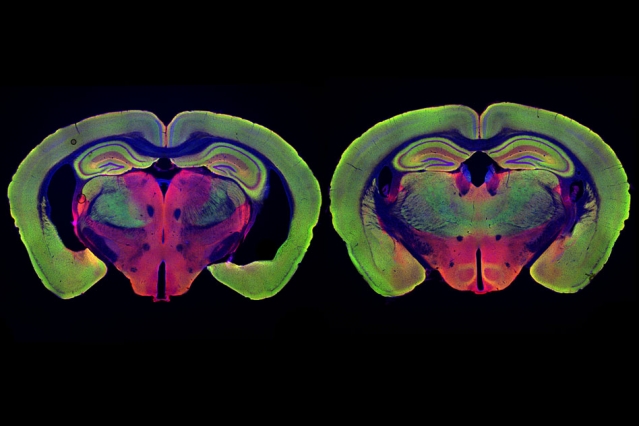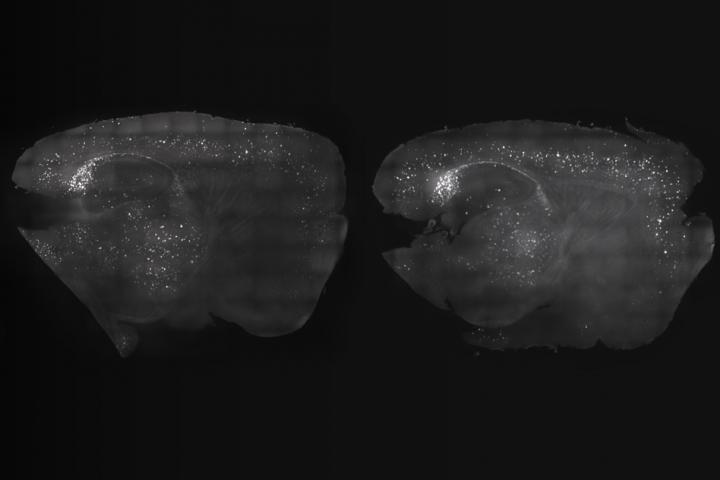A study finds gamma light therapy — flickering lights that mimic the brain's natural rhythm — reduced brain inflammation and cell death.
A study launched over two years ago using gamma light therapy to reduce beta-amyloid plaques in mice has proven to be a non-conventional treatment for the beginning hallmarks of Alzheimer’s in the animals. Now, that research has gone one step further in determining it’s not only neurons that benefit but also immune cells in the brain.
“It seems that neurodegeneration is largely prevented,” says Li-Huei Tsai, the director of MIT’s Picower Institute for Learning and Memory and the senior author of the study.
How gamma 40hz light therapy impacts the brain
The latest study, published in the journal Neuron, found the microglia, known as the janitors of our brains, were greatly aided through gamma light therapy — lights that flicker at a certain frequency (40hz) to mimic the brain’s natural rhythm. Specifically, they found that the light therapy had an overall impact on a reduction of inflammation and cell death in the mice.
They split the mice into two groups — one that had a mutated version of the Tau protein (Tau P301S) and another which produced a protein (CK-p25) that causes severe neurodegeneration. Both these groups were predisposed to a much greater neuron loss than the Alzheimer’s mice in the original study.
The researchers found that visual stimulation, given one hour a day for three to six weeks, had dramatic effects on neuron degeneration. They started the treatments shortly before degeneration would have been expected to begin, in both types of Alzheimer’s models. After three weeks of treatment, the Tau P301S mice showed no neuronal degeneration, compared to the untreated mice that had lost 15 to 20 percent of their neurons. Neurodegeneration was also prevented in the CK-p25 mice, which were treated for six weeks.
“I have been working with p25 protein for over 20 years, and I know this is a very neurotoxic protein. We found that the p25 transgene expression levels are exactly the same in treated and untreated mice, but there is no neurodegeneration in the treated mice,” Tsai says. “I haven’t seen anything like that. It’s very shocking.”
The study also found that it improved the performance of spatial tests in older mice that didn’t have a predisposition to Alzheimer’s disease but had no impact on young healthy mice.
Previous research on gamma light therapy and Alzheimer’s
In the original light therapy study, mice were also administered flashes of LED light at 40 hertz. Those findings showed it helped to clear both beta-amyloid and tau in mice engineered to have Alzheimer’s.
A later version of the study added sound in the form of clicking noises. Both studies were successful in increasing gamma waves or oscillations in the mice brains. These brain waves are sort of like the conductors of the brain — they keep everything moving and in check. Gamma waves occur when several neurons fire at once, creating a synchronized pattern of electrical activity.
With the added clicking noise, the amyloid-clearing effects expanded from the visual cortex to the auditory cortex and hippocampus, both key in memory processes, and the prefrontal cortex, an area of the brain that manages executive decision-making and planning. However, the effects of the dual treatment faded just a week after the therapy was administered.
Researchers are now turning to the unanswered question of how gamma oscillations brought on by light therapy trigger protective benefits to the brain.
Phase 1 clinical trials of light and sound stimulation in human patients is still in an early stage. Researchers also plan to test the gamma light treatment in mice with more advanced symptoms, to see if neuronal degeneration can be reversed after it begins.
[Interview with Li-Huei Tsai: An Out-of-the-Box Approach to Alzheimer’s Treatment: When Will Alzheimer’s Light Therapy Be Available?]
Image: Chinnakkaruppan Adaikkan/MIT, lead author of study



Hello.
Where can one get more information on this? I see many videos but no one talks about products and usage.
Thank you!
Diana
Please see the Reversal Solutions Product (Auragen Light and Sound System) at the web site ReversalSolutions.com
Hi Diana, I have checked it out and a few products are showing up. So far Reversal Solutions seems to have the best option.
Are there any trials in the Chicagoland area?
Thank you.
There are products for sale but I have no idea if they meet the requirements for similar results. It would be good to know what to look for since products are available.
Yes, Sophia, I see cheap ones that just seem like Christmas tree lights for sale, with no great reviews. Then there are the expensive ones that I wouldn’t want to purchase without knowing if they are the real thing. Also, I want to know if looking at these lights are a danger to one’s vision.
Is there a way to apply for clinical trials?
This sounds quite promising and my mother could benefit from this. Unfortunately she is not in the US, is it still possible?
Please refer to this website for clinical trials:
https://www.clinicaltrials.gov/